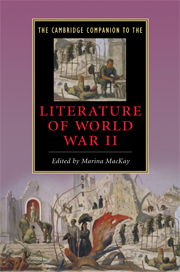4 - The American war novel
from Part I - Anglo-American texts and contexts
Published online by Cambridge University Press: 28 May 2009
Summary
The United States entered the war late, but its cost in blood and treasure for the nation was staggering: over 400,000 dead and more than 600,000 wounded. Marching into the appalling bloodletting of Europe, Asia, and Africa - many put total world fatalities at 60 million or higher - the United States would be radically transformed. The astonishing breadth of these changes is best symbolized in the distance between two of its most important war-related creations: the atomic bomb and, through the sponsorship of Eleanor Roosevelt, the Universal Declaration of Human Rights. The immediate fictional response to the war, however, was not the watershed that might have been expected from such tumult. A great deal of readable, competent work was produced and lavishly celebrated - like Irwin Shaw's engaging if formulaic The Young Lions (1948) or Herman Wouk's prim but somehow irresistible The Caine Mutiny (1951) - but few of these novels marked new directions for literature and fewer still are given extended attention by literary critics today. It is a much smaller subset of works that is now widely taken as the most important art coming out of the conflict, all of it published after the war ended, including Norman Mailer's punishing The Naked and the Dead (a first novel so successful as to almost ruin the 25-year-old, by making what came after seem a failure), Joseph Heller's hilarious and grim Catch-22 (panned by the New York Times in 1961 “for want of craft and sensibility ”), and the absurdist pair of Kurt Vonnegut's Slaughterhouse-Five and Thomas Pynchon's Gravity's Rainbow.
- Type
- Chapter
- Information
- Publisher: Cambridge University PressPrint publication year: 2009

